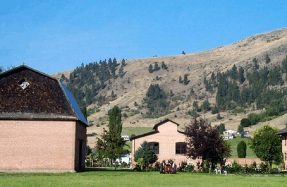
The Hudson Bay Company’s Fur Brigade Trail from Fort Hope to Kamloops was constructed in the 1840s—long before there was a British Columbia. More than 100 years later, it was reconstructed as a trail for hiking and recreation.1
By 1840, the HBC faced a dilemma. The American Boundary Commission planned to extend their boundary from the Rocky Mountains along the 49th parallel to the Pacific Ocean. This would put an end to the HBC’s route from its northern forts in New Caledonia down the Columbia river to its mouth at Fort Vancouver.
In 1845, A.C. Anderson, the company’s chief trader at Fort Alexandria (south of Quesnel) offered to search for a new overland fur brigade route from Fort Kamloops to the company’s new depot at Fort Langley. Oceangoing ships for the HBC would ply the waters of the Fraser River up to Fort Langley to load the


